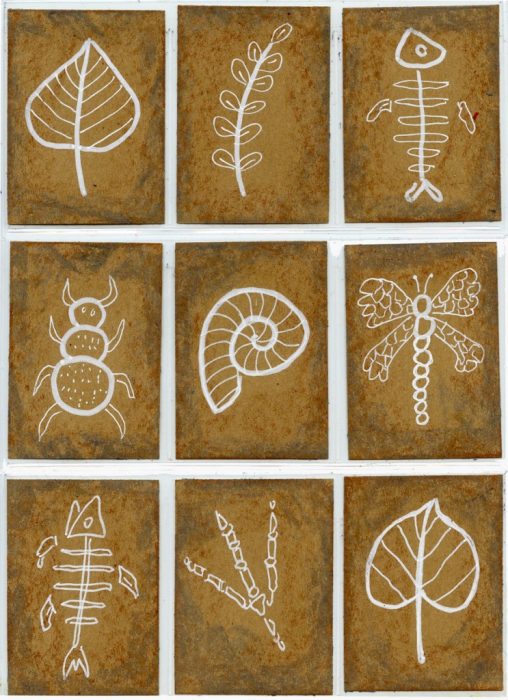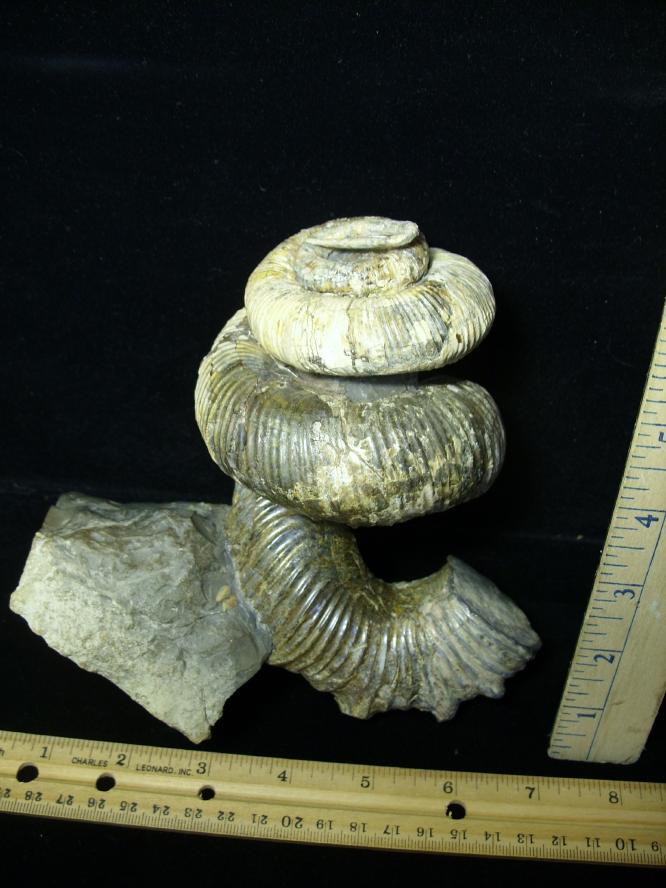Table of Content
Is a fossil found in rock that accumulated significantly later than when the fossilized animal or plant died. Reworked fossils are created by erosion exhuming fossils from the rock formation in which they were originally deposited and their redeposition in a younger sedimentary deposit. A transitional fossil is any fossilized remains of a life form that exhibits traits common to both an ancestral group and its derived descendant group. This is especially important where the descendant group is sharply differentiated by gross anatomy and mode of living from the ancestral group. Because of the incompleteness of the fossil record, there is usually no way to know exactly how close a transitional fossil is to the point of divergence.

Index fossils are fossils used to define and identify geologic periods . They work on the premise that, although different sediments may look different depending on the conditions under which they were deposited, they may include the remains of the same species of fossil. The shorter the species' time range, the more precisely different sediments can be correlated, and so rapidly evolving species' fossils are particularly valuable. The best index fossils are common, easy to identify at species level and have a broad distribution—otherwise the likelihood of finding and recognizing one in the two sediments is poor. According to one hypothesis, a Corinthian vase from the 6th century B.C.
Dinosaur Posters Dinosaur Wall Art Dinosaur Decor
The tomography technique provides previously unattainable three-dimensional resolution at the limits of fossilization. Fossils of two enigmatic bilaterians, the worm-like Markuelia and a putative, primitive protostome, Pseudooides, provide a peek at germ layer embryonic development. These 543-million-year-old embryos support the emergence of some aspects of arthropod development earlier than previously thought in the late Proterozoic. The preserved embryos from China and Siberia underwent rapid diagenetic phosphatization resulting in exquisite preservation, including cell structures. This research is a notable example of how knowledge encoded by the fossil record continues to contribute otherwise unattainable information on the emergence and development of life on Earth. For example, the research suggests Markuelia has closest affinity to priapulid worms, and is adjacent to the evolutionary branching of Priapulida, Nematoda and Arthropoda.

The specific fossil to use to alleviate or cure an illness is often based on its resemblance to the symptoms or affected organ. The usefulness of fossils as medicine is almost entirely a placebo effect, though fossil material might conceivably have some antacid activity or supply some essential minerals. The use of dinosaur bones as "dragon bones" has persisted in Traditional Chinese medicine into modern times, with mid-Cretaceous dinosaur bones being used for the purpose in Ruyang County during the early 21st century. William Smith (1769–1839), an English canal engineer, observed that rocks of different ages preserved different assemblages of fossils, and that these assemblages succeeded one another in a regular and determinable order. He observed that rocks from distant locations could be correlated based on the fossils they contained.
dinosaur fossil foot print 180 million yrs old
Fossils have been visible and common throughout most of natural history, and so documented human interaction with them goes back as far as recorded history, or earlier. If you are a fan of science, it's a must see in Frankfurt. Nice place to take the kids, but it's also really fun for all ages. Metaphysical Mini Selenite cleansing bowl paired with mixed gemstones.
Fossil sites with exceptional preservation—sometimes including preserved soft tissues—are known as Lagerstätten—German for "storage places". These formations may have resulted from carcass burial in an anoxic environment with minimal bacteria, thus slowing decomposition. Lagerstätten span geological time from the Cambrian period to the present. Worldwide, some of the best examples of near-perfect fossilization are the Cambrian Maotianshan shales and Burgess Shale, the Devonian Hunsrück Slates, the Jurassic Solnhofen limestone, and the Carboniferous Mazon Creek localities. Synchrotron X-ray tomographic analysis of early Cambrian bilaterian embryonic microfossils yielded new insights of metazoan evolution at its earliest stages.
Fish fossil
Robert Hooke (1635–1703) included micrographs of fossils in his Micrographia and was among the first to observe fossil forams. His observations on fossils, which he stated to be the petrified remains of creatures some of which no longer existed, were published posthumously in 1705. A 2009 discovery provides strong evidence of microbial stromatolites extending as far back as 3.45 billion years ago. Some of the most remarkable gaps in the fossil record show slanting toward organisms with hard parts. The process of fossilization varies according to tissue type and external conditions.

The vast bulk of subfossil material comes from Quaternary sediments, including many subfossilized chironomid head capsules, ostracod carapaces, diatoms, and foraminifera. Trace fossils consist mainly of tracks and burrows, but also include coprolites and marks left by feeding. Trace fossils are particularly significant because they represent a data source that is not limited to animals with easily fossilized hard parts, and they reflect animal behaviours.
Replica Wooden Wall DecorationThis principle became one of Darwin's chief pieces of evidence that biological evolution was real. Organisms are only rarely preserved as fossils in the best of circumstances, and only a fraction of such fossils have been discovered. The transition itself can only be illustrated and corroborated by transitional fossils, which will never demonstrate an exact half-way point. Subfossils are often found in depositionary environments, such as lake sediments, oceanic sediments, and soils. Once deposited, physical and chemical weathering can alter the state of preservation, and small subfossils can also be ingested by living organisms. Subfossil remains that date from the Mesozoic are exceptionally rare, are usually in an advanced state of decay, and are consequently much disputed.
In modern microbial mats, debris from the surrounding habitat can become trapped within the mucus, which can be cemented by the calcium carbonate to grow thin laminations of limestone. These laminations can accrete over time, resulting in the banded pattern common to stromatolites. The domal morphology of biological stromatolites is the result of the vertical growth necessary for the continued infiltration of sunlight to the organisms for photosynthesis. Layered spherical growth structures termed oncolites are similar to stromatolites and are also known from the fossil record. Thrombolites are poorly laminated or non-laminated clotted structures formed by cyanobacteria common in the fossil record and in modern sediments.
'obtained by digging') is any preserved remains, impression, or trace of any once-living thing from a past geological age. Examples include bones, shells, exoskeletons, stone imprints of animals or microbes, objects preserved in amber, hair, petrified wood and DNA remnants. Paleontology has joined with evolutionary biology to share the interdisciplinary task of outlining the tree of life, which inevitably leads backwards in time to Precambrian microscopic life when cell structure and functions evolved. The study of fossils, on the other hand, can more specifically pinpoint when and in what organism a mutation first appeared. Phylogenetics and paleontology work together in the clarification of science's still dim view of the appearance of life and its evolution.

Small scale permineralization can produce very detailed fossils. For permineralization to occur, the organism must become covered by sediment soon after death, otherwise the remains are destroyed by scavengers or decomposition. The degree to which the remains are decayed when covered determines the later details of the fossil.
Since Darwin's time, the fossil record has been extended to between 2.3 and 3.5 billion years. Most of these Precambrian fossils are microscopic bacteria or microfossils. However, macroscopic fossils are now known from the late Proterozoic. The Ediacara biota dating from 575 million years ago collectively constitutes a richly diverse assembly of early multicellular eukaryotes.
Subfossils are often found in caves or other shelters where they can be preserved for thousands of years. The main importance of subfossil vs. fossil remains is that the former contain organic material, which can be used for radiocarbon dating or extraction and sequencing of DNA, protein, or other biomolecules. Additionally, isotope ratios can provide much information about the ecological conditions under which extinct animals lived. Subfossils are useful for studying the evolutionary history of an environment and can be important to studies in paleoclimatology.
Ancient Bryozoan fossils Ordovician period 3oz Lot
This and other data led Stephen Jay Gould and Niles Eldredge to publish their seminal paper on punctuated equilibrium in 1971. Interest in fossils, and geology more generally, expanded during the early nineteenth century. In Britain, Mary Anning's discoveries of fossils, including the first complete ichthyosaur and a complete plesiosaurus skeleton, sparked both public and scholarly interest.

No comments:
Post a Comment